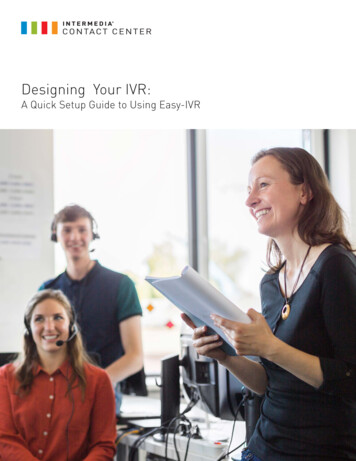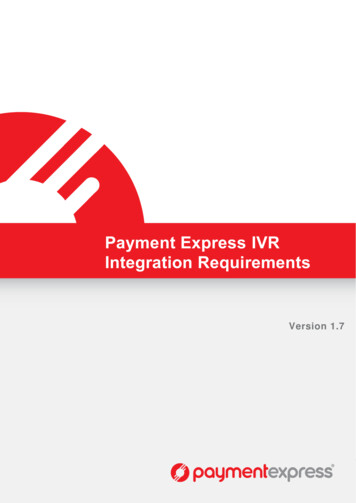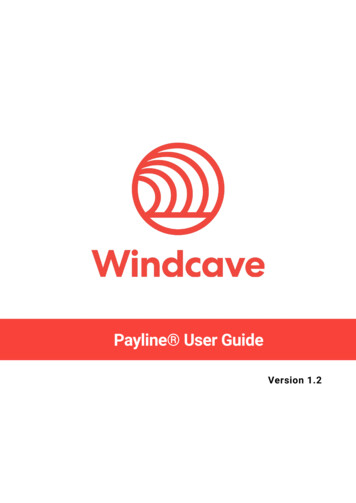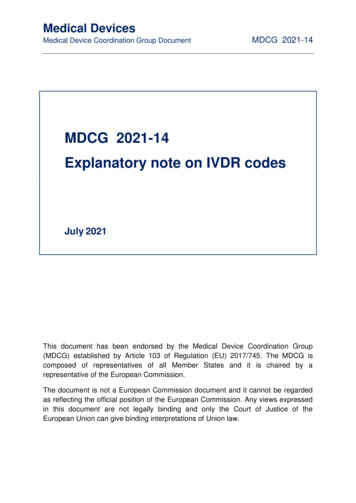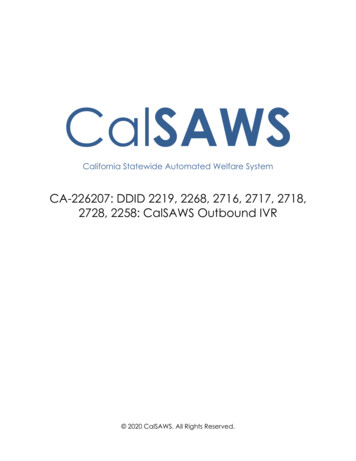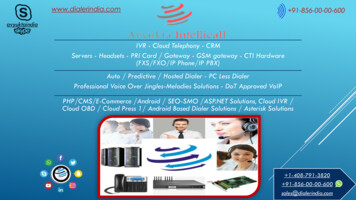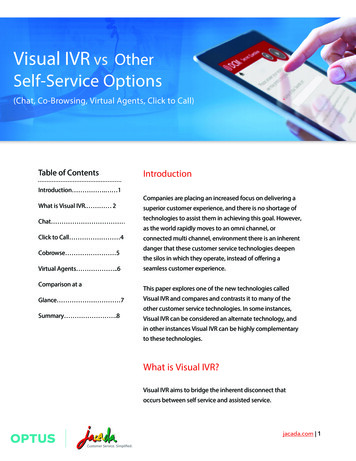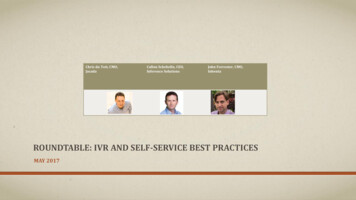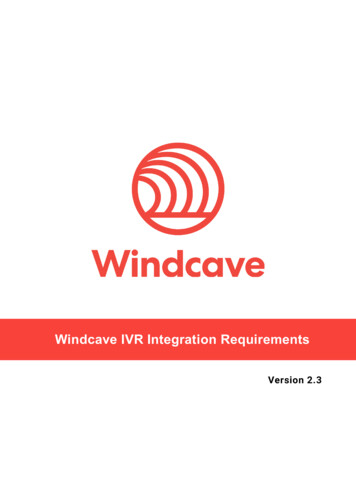
Transcription
Windcave IVR Integration RequirementsVersion 2.3
Copyright Copyright 2019, Windcave Ltd33 Wilkinson Road,PO Box 8400Auckland 1060New Zealandwww.windcave.comAll rights are reserved. No part of this work may be reproduced or copied in any form or by any means,electronic or mechanical, including photocopying, without the express written permission of WindcaveLimited.Proprietary NoticeThe information described in this document is proprietary and confidential to Windcave. Anyunauthorised use of this material is expressly prohibited except as authorised by Windcave Limited inwriting.
Contents12Introduction . 41.1Background and Overview . 41.2Assumptions . 4Call Script Process flow . 52.1CUstomisation of the standard call script . 92.2session initiated ivr . 93Audio File Requirements . 124Transaction Outcomes . 154.1Payline . 154.2Auto reports. 154.3Real-time Notification . 155Limitations . 166Testing. 167Appendix . 17General Glossary:. 17Windcave IVR Integration RequirementsPage 3 of 17Version: 2.3
1 Introduction1.1 Background and OverviewThe Windcave IVR provides the ability for a merchant to take phone based payments inside of aWindcave PCI compliant environment. The call scripts used are configurable and may be varied on aper customer basis. The purpose of this document is to show the default call script and to provide astarting point for merchants to design their own call scripts. Merchants wishing to customise their callscript will need to consult their allocated Implementation Consultant at Windcave to verify theirrequirements are able to be met.1.2 AssumptionsRefA01A02AssumptionWhen transferring a call to the WindcaveIVR the merchants system will fully detrombone the call.It is preferred that DTMF tones will bereceived by the Windcave system out ofband.Windcave IVR Integration RequirementsPage 4 of 17ReasonFailure to do so will mean DTMF tones pass throughthe merchants system and therefore leave them inscope for PCI requirementsOut of band DTMF tones are preferred as thisremoves risk of voice data being misinterpreted asDTMF tones, however we can work with in bandDTMF tones if required.Version: 2.3
2 Call Script Process flowThis section documents the Call script process flow of the standard (off the shelf Windcave IVR)High level with Entry pointCapturing the Transaction ReferenceWindcave IVR Integration RequirementsPage 5 of 17Version: 2.3
Capturing the Transaction AmountWindcave IVR Integration RequirementsPage 6 of 17Version: 2.3
Capturing the Credit card numberCapturing the Card Expiry DateWindcave IVR Integration RequirementsPage 7 of 17Version: 2.3
Capturing the Card Verification or Security Code (CVC or CSC)Processing the PaymentWindcave IVR Integration RequirementsPage 8 of 17Version: 2.3
2.1 Customisation of the Standard Call ScriptAlterations to the call script may be made as necessary; however any such alterations will impact thedevelopment timeframes. It is expected that in most cases merchants will require a way of matching orimporting a transaction into their system. This may be achieved by providing additional references for atransaction that is returned in the transaction result. This could be a customer Id or perhaps an invoicenumber. Or the call flow option to save the card. In this scenario we recommend altering ‘1.0 EntryPoint’ to give a general overview of the process flow and insert a new call flow similar to the flow ‘1.1Capture Reference’ shown above.Another common requirement is to have a merchant-provided unique identifier for a transaction. Thecall script can be structured at the 1.0 Entry Point to have the numeric data, as DTMF tones, passed inby the merchants system before transferring the call thus making this step invisible to the cardholderentering their card details. Alternatively a prompt may be added to ask the cardholder to provide thereference (such as an invoice Id). The timeout duration and retry counts can also be configured per callflow.So the functionality of the IVR call flows can be customised to suit the merchant’s needs on a case bycase basis. Additional charges may apply, please contact one of our Sales representatives(sales@windcave.com) for more information. Preferably the low level prompts shown in the call flowsabove would not need to be changed but the need may arise to obtain additional input parameters fromthe cardholder. It is suggested that any additional prompts appear before the prompts to capture cardinformation.If this is required please document the changes to process flow as above and supply revised diagramswith details to your Windcave Implementation Consultant (once available and project has beeninitiated) for verification. This will also ensure the custom IVR solution can be efficiently implementedby the Windcave Development team.2.2 Session Initiated IVRInstead of initiating the IVR transaction when the call to our IVR is connected, alternatively themerchant’s system can send an API request with the transaction details such as merchant referencesand amount. The API response to the merchant’s system will contain a Windcave generated session IDfor the transaction to occur via IVR. The merchant’s system will dial the Windcave IVR and transmit thesession ID as DTMF tones to the connected IVR call. The IVR call flows proceeds where the customer isprompted to enter the card details for the payment to be processed on the session ID.This allows the call flows to capture the reference and amount to be skipped as those transactionrequest details are already associated with the session ID.Windcave IVR Integration RequirementsPage 9 of 17Version: 2.3
1.The merchant’s system sends a create session request with the transaction details (such asamount, transaction reference, merchant’s notification URL, etc) using the Windcave API. TheAPI documentation will be provided on request.The API credentials for testing and live usage will provided by our Support team on request.2.The valid create session API request will return the session Id for the merchant to capture.3.The merchant’s system extracts the last 16 characters of the session ID and converts the last16 characters to decimal numbers (in base-10).4.The merchant’s system dials the Windcave IVR phone number, when the call is connected,merchant’s system passes the decimal numbers of the session ID as DTMF tones.5.After the merchant’s system transfers the call to the customer, the customizable call flows(shown above) contains various steps to prompt the card details.6.Once the transaction is processed, the merchant’s system receives a notification to the URLspecified in step 1 above. The notification received to the merchant system contains thetransaction outcome. Alternatively on receiving a notification the merchant system can alsoquery the full original session ID using the Windcave API query session request.The standard call flows for the session initiated IVR are below. The Capture Card details call flowremain the same as per call flow diagrams numbered 1.3 to 1.5.Windcave IVR Integration RequirementsPage 10 of 17Version: 2.3
Entry Point with SessionIdProcess Payment for the Session Initiated IVRWindcave IVR Integration RequirementsPage 11 of 17Version: 2.3
3 Audio File RequirementsEach of the Prompts in the call script will require one or more audio files to be played. It is expected thatthe Windcave customer requesting the IVR will supply similar files named accordingly. The Call scriptprompts below are a guide and the customer may choose to alter the prompt’s wording for a given fileprovided the change does not influence the expected behaviour of the cardholder at the given prompt.Alternatively, a text to speech option is available for customers not wishing to provide their own customvoice files. It is recommended that files have consistent quiet space at beginning and end so that whennumbers are being played back to cardholders the speech pattern is consistent.The audio file format and metadata should be exactly 16-kHz LPCM @ 16-bits/sample.Call Script PromptsPrompt1.0-11.1-11.1-2File av1.6-5.wavWindcave IVR Integration RequirementsPage 12 of 17Call ScriptWelcome to Merchant Name IVR.Please enter your transaction reference, followed by the # key.The reference number you have entered is transactionreference . If this is correct, press the # key. To re-enter thetransaction reference, press the * key.We are sorry, we have not detected your input.The transaction reference entered is invalid.The input you have entered is invalid.Please enter the amount you wish to pay followed by the #key.The amount to pay you have entered is pay amount . If thisis correct, press the # key. To re-enter the pay amount, pressthe * key.The amount entered is invalid.Please enter your credit card number, followed by the # key.The card number you have entered is card number . If this iscorrect, press the # key. To re-enter the card number, pressthe * key.The credit card number you have entered is invalid.Please enter the card’s expiry date in month month, year yearformat followed by the # key.The expiry date entered is expiry date . If this is correct,press the # key. To re-enter the expiry date, press the * key.The expiry date you have entered is invalid.Please enter your card security code followed by the # key.This is usually located on the back of your card.The CVC code you have entered is CVC code . If this iscorrect, press the # key. To re-enter the CVC code, press the *key.The card security code you have entered is invalid.Please wait while your transaction is processed.Thank you. Your transaction has been approved.I am sorry, your transaction has been declined. Your creditcard has not been charged.Your authorisation number is authorisation number .We are sorry but you have exceeded the maximum number ofattempts. Thank you for using this service, goodbye.Version: 2.3
archAprilMayJuneJulyFile .wavIf you wish to make another payment, press the # key again,otherwise hang up now.Thank you for using this service, goodbye.The amount to pay you have entered is pay amount .Playback PromptsWindcave IVR Integration RequirementsPage 13 of 17Call ebruaryMarchAprilMayJuneJulyVersion: 2.3
tNotes:* Should be read as “star”# should be read as “hash”Windcave IVR Integration RequirementsPage 14 of 17Version: 2.3
4 Transaction OutcomesIVR transactions take place on the Windcave system; therefore the need arises to have mechanismsthat will allow the Merchants system to become aware of transactions that have been processed. Thereare various options available to achieve this.4.1 PaylineA user account to log into the Windcave Payment Manager portal to view the transaction detailsprocessed. Transaction Reports can also be generated and downloaded through the portal.4.2 Auto reportsA Report that contains transactions processed on a merchant account may be generated and sent on aperiodic basis (usually daily). The method of delivery is optional between SFTP and email. Pleasecontact one of our Sales representatives (sales@windcave.com) for more information.4.3 Real-time NotificationA real-time notification response after the IVR transaction may be generated with the transactiondetails and sent to an API endpoint or web server hosted by the merchant. This option allows amerchant to update their system in real time with transaction outcomes. The notification with thetransaction outcome details can be sent as HTTPS POST with the JSON payload. For the notificationsent as a SOAP payload there is additional development and customisation task required by ourDevelopment team.The transaction outcome information is within the notification payload. It is recommended to recordthese details your own system’s transaction outcome details.Following are the common transaction outcome fields:MerchantReference - this is a merchant generated reference for the transaction if one is required - ifneeded the reference would need to be passed via DTMF tones at the beginning of the call to theWindcave IVR.TxnRef - a Transaction Reference can be generated by the merchant - passed via DTMF tones. If not,then Windcave will generate one, so there will always be a TxnRef.Transaction Id or DpsTxnRef - always generated for every transaction on the Windcave gateway. This isa unique identifier for the transaction on our system - this is the best way to identify an individualtransaction when troubleshooting or resolving an issue so your application should include it in yoursystem’s transaction outcome details.BillingId - a merchant generated token used for card tokenization - passed via DTMF tones at thebeginning of the call to the Windcave IVR.CardId or DpsBillingId - a Windcave generated token used for card tokenization that is always returned iftokenization is enabled.CardNumber2 - A card token generated by Windcave when saving or tokenizing a card for recurringbilling. CardNumber2 is a 16 digit number which conforms to a Luhn 'mod 10' algorithm and has a 1-to1 relationship with the actual card number used. Please contact Windcave support if you would like touse this value.ReCo - Response Code. A successful transaction will have '00' as the response code.AuthCode - this is the reference passed from the Merchant’s Bank confirming Authorisation of thetransaction by the Card Issuing Bank.Windcave IVR Integration RequirementsPage 15 of 17Version: 2.3
TxnData1, TxnData2, TxnData3 - optional reference fields for a given transaction that the merchant canuse if required - would be set by the merchant and passed via DTMF tones at the beginning of the callto the Windcave IVR.5 LimitationsThe IVR can accept / allow the cardholder to input buttons over the top of the audio files. However, onlythe last audio file in a prompt (that contains a sequence of audio files) may be skipped by user input.6 TestingOnce a test version of your IVR solution has been deployed in our UAT environment, you will need totest the IVR solution to confirm that it meets your requirements and expectations. It is recommendedthat this testing replicates as much as possible the expected behaviour in any of your systems thatreceive the IVR transaction outcomes.A test IVR will be made available for the merchant to perform UAT validation that the IVR meets theiragreed upon requirements. Once the Merchant has signed off the IVR requirements they may requestthe IVR scripts be deployed into the production environment. The environment will remain available for5 working days following the production deployment. After which it may be taken down and madeavailable to other merchants waiting for development testing.Windcave IVR Integration RequirementsPage 16 of 17Version: 2.3
7 AppendixGeneral Glossary:TermDescriptionAPIApplication Programming Interface.AssumptionA condition not certain to happen, outside the control of the project, and necessaryfor the project or solution to be successful.DTMFDual-Tone Multi-Frequency. Dual-tone multi-frequency signalling is an in-bandtelecommunication signalling system using the voice-frequency band overtelephone lines between telephone equipment and other communications devicesand switching centres.IVRInteractive Voice Response.PCIPCI DSS is a comprehensive set of requirements created by the Payment CardIndustry Security Standards Council for enhancing cardholder data security and toensure the safe handling and storage of sensitive customer credit card information/ data.UATUser Acceptance Testing.Windcave IVR Integration RequirementsPage 17 of 17Version: 2.3
1.3-1 1.3-1.wav Please enter your credit card number, followed by the # key. 1.3-2 1.3-2.wav The card number you have entered is card number . If this is correct, press the # key. To re-enter the card number, press the * key. 1.3-4 1.3-4.wav The credit card number you have entered is invalid.


